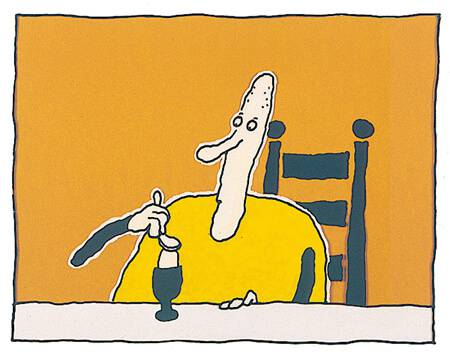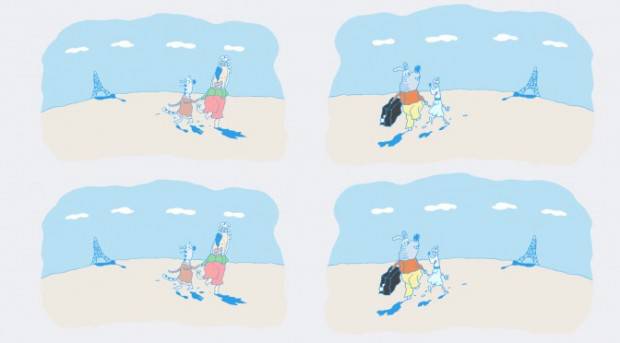An Interview with Animation Director Paul Driessen
Presently based in France, Dutch-Canadian animation director Paul Driessen has been consistently prolific in the world of animated shorts since the early seventies. Initially developing his style at the National Film Board of Canada, Paul has subsequently produced over twenty-five films both in Canada and the Netherlands. Amongst these are such acclaimed works as The Killing of An Egg, 2D or Not 2D and the Oscar-nominated 3 Misses. His recent NFB film Cat Meets Dog – produced by Marcy Page and Maral Mohammadian and co-produced in The Netherlands and Belgium – has screened internationally at festivals including HAFF, NFF and Sitges with an upcoming screening this weekend at Geneva’s Animatou. The film embraces several traits of Paul’s signature style, depicting interweaving narratives and realities through use of split screen and manipulating time in a manner evocative of prior work such as The Boy Who Saw the Iceberg and Oedipus. We’re proud to welcome Paul Driessen to Skwigly to hear more about his extensive and intercontinental career.
Your relationship with the NFB goes back about forty years, one of the earliest films of yours I’m familiar with being An Old Box (above) – at that point how long had you been in Canada?
When I made An Old Box I had been living in Canada for five years – actually I moved to Canada because of the National Film Board. I had just worked in London on George Dunning’s The Yellow Submarine. George was Canadian, he was trained at the Film Board and talked about it. After The Yellow Submarine I moved to Canada in the early seventies and worked at Potterton Productions in Montreal in order to just get my trip paid for; I was quite poor at the time. From there I waked into the Film Board with ideas. Because my English was better than my French, I tried the English animation department first but finally it was the French studio who took me in. I stayed there for many years, but as a freelancer. So I made films in Canada, went back to Holland in between, made films there subsidized by the Dutch government; I traveled a lot between the two countries.
Is there a vast difference between the filmmaking circumstances of each country from a creative or production standpoint?
I’ve made many, many films at the Film Board and it’s always really a nice environment for filmmakers like me to work. The Film Board is a good place for mixing with all the other animators also working on their own films, it’s like a little family and it makes it a very pleasant environment to work, share ideas and talk about your work.
In Holland I would be renting a room somewhere and working from home which is kind of fun too, especially when you’re young. It was a beautiful summer when I started working on David and The Killing of an Egg (1977) after my first few films at the Film Board, so I stayed for a year. It was lovely as an experience and I’m used to working by myself, but coming back to the film board felt good again, to be part of that group.
It’s great to have two nationalities – I can work in Canada or in Holland, which helped me a lot with getting budgets. If the Film Board wouldn’t take an idea of mine I would go to Holland or Belgium or elsewhere in Europe where they might like it. I’ve done a lot of co-productions lately and if you’re only from one country you cannot do that, it’s really a privileged situation.
Going back to The Yellow Submarine, did that have a big effect on your approach and style or was it more a case of you cutting your teeth in the animation world?
I had started out not too long before that. Basically it’s because George Dunning had come to Holland, to the studio where I worked, to see the progress of the work they’d done for The Beatles TV series. I didn’t work on that series myself but George liked my style and said “Whenever you want, come to England”. So when the small Dutch studio collapsed in ’66-’67 I went over to the UK and just by chance they’d happened to start on The Yellow Submarine. The beginning was quite chaotic, they didn’t have a script or anything. Sgt. Pepper’s had just come out and they wrote the script around it. I remember the film had to be made very quickly, because it would only sell if The Beatles were still popular, so nine months was the deadline. They made the deadline and The Beatles never stopped being popular!
As someone who’s been involved with the NFB time and again over a few decades, are there any ways that the NFB has changed or adapted over the years?
The techniques have changed quite a lot, of course, which has affected the style of the NFB productions. In the early days the French studio invited well-known Czech or French animators (Pojar, Foldes) and the English studio had more interest in the cartoon style of the Zagreb school (Grgic, Kolar). The English studio worked more for the government and the French, where I made my films, was a younger department. Most of those films were non-narrative (the French language is of course spoken by a minority in North America), they were based on expression and visual imagery which was much more interesting for me.
I think I worked at the French studio, off and on, for about ten years. Then I returned to Holland for a while. In 1990 Marcy Page of the English animation department invited me back to the NFB and, all of a sudden, I was part of the English animation studio! Nowadays the two studios mix much more than in the old days. They’re located on the same floor, they share the same technology and are genuinely interested in each other’s work; in the old days they seemed two separate worlds, which was quite strange to me.
Certainly your work remains very much action-oriented, and the particular design style that you have is so identifiable. Was that always the way you approached drawing or was it consciously developed?
No, not consciously. When I was little I made funny drawings, one-panel cartoons. I just happened to get into animation, a bit by chance again, and the style kind of developed from childish and cartoony to what I do now. My style of animation itself used to be quite limited, as with The Yellow Submarine and early sixties commercials, when limited animated was popular, brought about by the UPA movement. I grew up with that style of course, which was a lot of fun – it’s simple and it goes fast. It’s only over maybe the last ten years that I really appreciated animation itself for its fullness, how far you can go and how much you can stretch. It’s more work of course but for an animator it’s quite exciting to do. In my later films, like Oedipus, if you look at the animation frame-by-frame the images are pretty weird, sometimes I leave out bodies, volumes, you’ll see only the eyes and the line, dimensions change, but it’s all very fluid, it just keeps going.
Playing with time is another interesting recurring theme in your work, I’ve noticed…
I animated Oedipus backwards, actually! The choice was to animate forwards and reverse it on the computer, which I tried but then all the anticipatory movement, all the fun of what you can do with animation to introduce a movement, would not work anymore because it’s the other way around. So instead I animated it as I would going forwards except I made the characters move backwards and tell the story backwards. I think in general that’s what gives the film a special feeling.
Another thing I particularly enjoy about Oedipus are all the Canadian animation ‘cameos’ who show up – was that something the original artists were in on?
We had to ask them – and they all agreed – if they would lend their character to me to do whatever I wanted to do with them. The Film Board is interesting in that the films they produce should all be different. In my case, the characters I borrowed are a variety of cartoon misfits. They’re all from crazy films, have family related problems and they should be analysed! So I put the whole bunch of them in that room.
From a technical perspective, I would assume that nowadays you animate digitally…
I don’t, I always animate on paper. I love to draw, I like the material. I brought a Cintiq to France to change my ways but when I started my new film I still had paper sitting here – the problem with paper is that you need it to be punched, and if you run out of any of the materials you need, living in a small village in the South of France somewhere, you have to order from England or Canada or Belgium, which takes a long time. Of course at the Film Board all these things are available but in a small village it’s different. So I felt I needed a Cintiq to be able to keep working but in the end I realized that I had enough paper to get me through this new production.
I need time to sit back and get used to the new computer programs but when you get older you want to get things done instead of spending time on technology. I’m still excited about the films I want to make and I don’t want to delay it too much, so I’m still animating on paper. I scan them into the compute, though.
Cat Meets Dog certainly feels like there were some digital process involved.
For the placing of the four panels, for instance, I would just animate my scenes right in the middle of my paper at a certain field-size and then at the Film Board they would distribute them over four panels. I would animate each panel separately, add some cycles and some freeze frames and feed the animation into the computer – I know how to direct my films on the computer but I couldn’t do the work myself. A lot of people can, but unfortunately not me.
Are you able to talk a bit about what you’re working on at the moment?
It’s a strange film called Disgusting Sounds People Make. I wrote a whole bunch of short cartoons that are kind of scatological, but next to being somewhat disgusting they’re also part of a more decent live-action/pixilation scanario. Years ago I proposed that project in Canada but North Americans in general don’t like that kind of thing. They might like violence, sex or whatever else is close to the human heart, but with scatological stuff you have to go to North European countries. The French actually like it too, they have terrific bande dessinée about really disgusting stuff – and the Germans and the Dutch love it! But I think to the Canadians it seemed like my idea was all about disgusting adolescent imagery, which I insist, it’s not. The story itself is quite interesting, I think, I hope…
Cat Meets Dog will screen at Animatou in Geneva this Saturday, October 3rd. Visit Paul Driessen online at pdriessen.com and to watch more of his films check out his NFB Director page.



